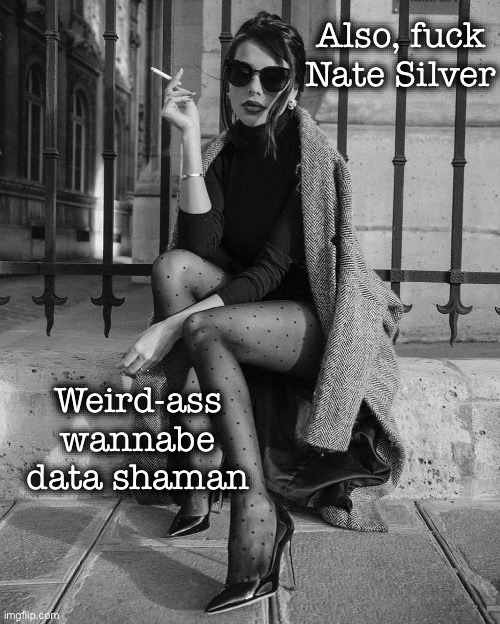#Nate silver
Text
I really feel like Nate Silver should be more of a rationalist icon than he is.
He's an outspoken Bayesian who believes in probabilistic reasoning and does explicit calibration tests of himself. He's incredibly good at this, producing consistently well-calibrated forecasts across multiple domains. (And he's winning!)
He even exemplifies the actual primary rationalist virtue, which is pissing people off by being contrarian on the internet.
I suspect he loses points for forecasting with actual math, rather than putting a number on his intuition and muttering something about priors. Doing math in your Bayesian updates is cheating!
288 notes
·
View notes
Text
By: Nate Silver
Published: Nov 2, 2023
“What Harvard students think” is a topic that invariably receives too much attention. But I don’t think that’s true for evaluating opinion among young people or college students in general — who, after all, will make up the next generation of journalists, business leaders, politicians and pretty much every other white-collar profession. And after seeing the latest polling on what college students think about free speech, I don’t concern over “cancel culture” or the erosion of free speech norms is just some moral panic. In fact, I think people are neglecting how quick and broad the shifts have been, especially on the left.
College Pulse and FIRE — the Foundation for Individual Rights and Expression, a pro-free speech advocacy group — recently published the latest edition of their annual survey. Although I don’t love using data from political groups — even ones I generally agree with — the good in this survey outweighs the bad. The methodology is detailed and transparent. And in surveying more than 55,000 undergraduates, the poll provides a look at student opinion across all sorts of colleges and universities — not just from the loudest or most privileged students at elite institutions.
Although I’ve seen a lot of media coverage about the FIRE survey, I’d never really dug into the details. I’m not sure exactly what I was expecting to see. But given my own political philosophy, I can tell you what I was hoping for: robust student support for free speech — perhaps in contrast to the often lukewarm support it receives among university administrators. Unfortunately, that’s not what the survey found. Here’s what it says instead:
College students aren’t very enthusiastic about free speech. In particular, that’s true for liberal or left-wing students, who are at best inconsistent in their support of free speech and have very little tolerance for controversial speech they disagree with.
Moreover, this attitude is broad-based — not just at elite schools. I was frankly surprised at how tepid student support was. A significant minority of students don’t even have much tolerance for controversial speech on positions they presumably agree with. There are partial exceptions at some schools — including my alma mater, the University of Chicago — suggesting the attitudes of professors and administrators play some role in trickling down to students. But this looks like a major generational shift from when college campuses were hotbeds of advocacy for free speech, particularly on the left.

[ A protest in favor of free speech as part of the Free Speech Movement at UC Berkeley. ]
Students have low tolerance for even mildly controversial speakers
The College Pulse/FIRE survey asks a long battery of questions, but many of them are focused on student perceptions about university administrators and not what they think about free speech themselves. Other questions ask about efforts to disrupt controversial speech — for instance, by shouting down a speaker. In these cases, there can be competing interpretations of what constitutes free speech — i.e. the students might say they are exercising free speech by disrupting the speaker — so these aren’t straightforward to interpret.
However, another set of questions directly asks students about their tolerance for controversial speech with no competing speech interest — specifically, whether a student group should be allowed to invite a speaker on campus. The exact wording of these questions is this:
Student groups often invite speakers to campus to express their views on a range of topics. Regardless of your own views of the topic, should your school ALLOW or NOT ALLOW a speaker on campus who previously expressed the following idea: ______________
Then, the survey presents students with a set of six examples — three pertaining to controversial ideas held by conservative speakers, and three about controversial ideas from liberal speakers. The order in which the students are presented with the examples is randomized in the survey — but here I’ll list them here with the conservative ideas first (which I’ve labeled as C1, C2 and C3) and the liberal ones (L1, L2, L3) second.
C1. Transgender people have a mental disorder.
C2. Abortion should be completely illegal.
C3. Black Lives Matter is a hate group.
L1. The Second Amendment should be repealed so that guns can be confiscated.
L2. Religious liberty is used as an excuse to discriminate against gays and lesbians.
L3. Structural racism maintains inequality by protecting White privilege.
Let me pause for an annoying little disclaimer. In today’s newsletter, I’m going to use the term “liberal” as synonymous with “progressive” or “left-wing”, even though I generally try to avoid that. Indeed, free speech is a bedrock principle of liberalism as classically defined. But since the FIRE survey uses “liberal” as a stand-in for left1, I’m going to do so as well.
OK, with that throat-clearing out of the way, let me show you the numbers, broken down by students’ self-described political orientation. The figures in the table reflect the percentage of students who would allow the speaker.

If you want to critique the examples FIRE chose, I’m sympathetic up to a point — the conservative statements seem slightly spicier than the liberal ones, although maybe that reflects my personal biases. I figured that the students would have a strong dislike for speakers C1 (“transgender people have a mental disorder”) or C3 (“Black Lives Matter is a hate group”) because they could be seen as promoting hate speech or misinformation. I don’t personally think “hate speech” and “misinformation” are terribly coherent categories, but leave that aside for now. This is a survey of college students, including some as young as 18. So I was just hoping to find general, directional support for free speech — even if not necessarily in every instance from first principles.
But I was much more surprised by responses to speaker C2 (“abortion should be completely illegal”). People obviously have strong feelings about abortion, and a complete abortion ban is unpopular. Still, this is a commonly-articulated, garden-variety unpopular political opinion that doesn’t make any sort of factual claim and can’t reasonably be construed as hateful. You’d think even students with a tentative, half-baked belief in free speech principles would tolerate it. And yet, 57 percent of students — including 68 percent of liberals — thought a speaker expressing this anti-abortion viewpoint shouldn’t be allowed on campus. That number kind of shocked me.
For that matter, tolerance for some of the liberal viewpoints isn’t all that high either. Only 57 precent of students think L2 — the speaker who says religious liberty is used as an excuse to discriminate against gays and lesbians — should be allowed, even though that sort of claim has been common in American political discourse for decades now
Still, to be clear, there’s a big gap between the liberal students and the conservative students. The conservatives are actually quite consistent, with roughly 60 percent support for both liberal and conservative speakers. The liberal students have a relatively high tolerance for liberal speakers, but little tolerance for conservative ones.
This isn’t just a Harvard problem
Harvard and other elite schools often rate poorly in FIRE’s overall free speech rankings — Harvard is dead last in the latest edition, in fact. But the survey data I’ve been describing is just one component of those rankings. When it comes to controversial speakers, students at non-elite colleges are just as intolerant as their Ivy League counterparts. Here are the average numbers across various college typologies:

You can look at this data in a couple of different ways. On the one hand, the Ivy League schools are slightly more tolerant of controversial speakers overall. On the other hand, they have a particularly wide gap between tolerance for liberal speakers and conservative ones. Students at elite small colleges — the so-called Little Ivy group — have an even bigger gap and stand out as being particularly inconsistent. Still, the numbers don’t differ that much from one type of institution to the next. As I’ve said, student support for controversial speech is low across the board.
What about at individual universities? I don’t want to make too much of these rankings because there are potential sample size issues — the survey polled a couple hundred students per school on average. So let me just list the top 5 and bottom 5 schools, which differ from the average enough to be comfortably outside the margin of error.

Hillsdale College, an expressly conservative university, unsurprisingly has off-the-charts tolerance for conservative speakers. To their credit, though, students there also have above-average tolerance for liberal speakers. Meanwhile, the University of Chicago, which has a long history of support for free speech — reiterated in 2014 in the form of something called the Chicago Principles — ranks third. Washington and Lee University, which adopted the Chicago Principles, ranks second.
Why did the campus left turn against free speech?
Rather than provide a comprehensive analysis of the reasons for this shift — perhaps we can go into more detail in future editions of this newsletter — let me just inventory a few hypotheses. By no means are these mutually exclusive — I suspect they all play a role.
Reason #1: Woke ideas are popular on campus and are considerably less tolerant of free speech than traditional liberalism
I’m at the point where I’m tired of putting the term “woke” in scare quotes. Although the word is sometimes abused by conservative politicians, there exists a distinctive and influential set of ideological commitments that differ from traditional liberalism or leftism. And wokeness — or whatever you want to call it — particularly differs from liberalism when it comes fo free speech, as James O’Malley writes:
The ideological shift that has surprised me the most is witnessing “free speech” become coded as a right-wing value, and something that when the phrase is uttered makes people sympathetic to “woke” ideas suspicious.
The argument is that unrestricted speech harms people. There isn’t an equal platform to speak in the first place, so racists and other unpleasant people are able to use the norm of free speech to terrorise groups who are oppressed.
I think the strangest example of this new norm in action was the response to Elon Musk buying Twitter. Traditionally, liberal ideology is fearful of overreach by powerful figures like billionaires, and is in favour of more permissive speech rules and norms as a hedge against their power. But the “woke” complaint about the new owner is that under Musk’s leadership, Twitter will not be censorious enough, and will be too permissive over what speech is allowed on the platform.
Reason #2: Normie Democrats are turning against free speech because of concerns over misinformation
However, wokeism isn’t the only left-of-center movement that has raised concerns about free speech. Rank-and-file Democrats have shifted on the question too and now strongly prioritize restricting false information over protecting freedom of information:

Note that this shift is fairly recent — it came between 2018 and 2021, so it can’t just be attributed to the election of Donald Trump. (Maybe it had something to do with COVID?) And it’s a big shift — Democrats went from 57/40 in favor of free speech over misinformation in 2018 to 28/70 against it in 2023. A change that large will inevitably trickle down into universities with their mostly liberal students, professors and parents.
Reason #3: The younger generation is risk-averse in general
Teens and young adults in the U.S. increasingly defy the stereotype of younger people taking more risks. Instead, they show increasing rates of depression and neuroticism, and decreasing rates of risky behavior such as drug use and sex. This is particularly true among young people who identify as liberal. If you think controversial speech can cause harm — from psychological trauma to actual, literal violence — you might conclude that it’s not worth the risk.
Reason #4: The United States may be reverting to the mean
The U.S. has historically been an outlier in public support for free speech, and our laws are more protective of it than in many other Western democracies. Britain, for example, has significant curbs on speech, as does Germany. If America is becoming less distinct from the rest of the world — not something I regard as a hard-and-fast fact but a plausible theory, especially in the multicultural environment of universities — we might expect support for free speech to decline.
Reason #5: The adults in the room are often hypocrites
I don’t think it’s always true that people are hypocritical about free speech. Some partisans literally can’t seem to understand that some of us at least strive for a more high-minded, principled approach, even if we don’t always live up to it. Thinking that everyone else is a hypocrite is a convenient belief to hold if you yourself are a hypocrite.
But is there a lot of hypocrisy around free speech? Of course there is. Republicans who rail against wokeness put significant limits of their own on academic freedom. Supposed “free speech absolutist” Elon Musk has often taken a censorious approach toward content he doesn’t like while tolerating censorship by foreign governments.
While I’ve somehow made it this far without using the words “Israel” or “Palestine”, recent international events have uncovered instances of hypocrisy too. I have no interest in refereeing every incident, but cases like this — in which editor-in-chief Michael Eisen was fired from the life sciences journal eLife for retweeting an Onion article that expressed sympathy with Palestinians — fall under any definition of “cancel culture”.
Meanwhile, major donors are reconsidering their contributions to universities whose administrations they say weren’t sufficiently critical of Hamas and the October 7 terrorist attacks. Personally, I think donating to an already-rich, elite private university is one of the least effective possible ways to spend your money, so I’m happy whenever donors find an excuse to pull back. But leaving that aside, I don’t think these donors have really thought through their strategy.
True, a lot of university presidents have expressed a conveniently-timed, newfound commitment to free expression that didn’t match their previous behavior. Still, if I were one of those donors, I’d say “great, and now we’re going to hold you to it. The next time you stray from your commitment to free speech — particularly when it comes to students or faculty who express conservative or centrist viewpoints — we’re going nuclear, permanently ending all contributions to the university and telling all our rich friends to do the same.”
And although I’m not sure I have any business talking to college students — although I have delivered a number of guest lectures and commencement addresses — if I were, I’d use this as a teaching moment, telling students that now that they’ve found out what it’s like to stand up for a controversial, unpopular position, I’d hope they’d be more respectful of the rights of others to do the same.
Because unless someone is willing to do that — to defend free speech in a principled, non-hypocritical way — the game theory says it’s just going to be a race to the bottom. And given the increasingly tenuous commitment to it in many corners of American society, free speech is going to lose out.
--
1 This is an understandable decision, given that it’s a survey of popular (student) opinion. In conducting a poll, you want to use language the respondents will understand and use themselves.
==
Reminder: Harvard received a 0.00 score out of a possible maximum of 100.0 in FIRE's College Free Speech Rankings.
In 2020, Harvard ranked 46 out of 55 schools. In 2021, it ranked 130 out of 154 schools. Last year, it ranked 170 out of 203 schools. And this year, Harvard completed its downward spiral in dramatic fashion, coming in dead last with the worst score ever: 0.00 out of a possible 100.00. This earns it the notorious distinction of being the only school ranked this year with an “Abysmal” speech climate.
What’s more, granting Harvard a score of 0.00 is generous. Its actual score is -10.69, more than six standard deviations below the average and more than two standard deviations below the second-to-last school in the rankings, its Ivy League counterpart, the University of Pennsylvania.
#Nate Silver#free speech#freedom of speech#freedom of expression#liberalism#liberal ethics#liberal values#illiberalism#censorship#cancel culture#religion is a mental illness
16 notes
·
View notes
Text




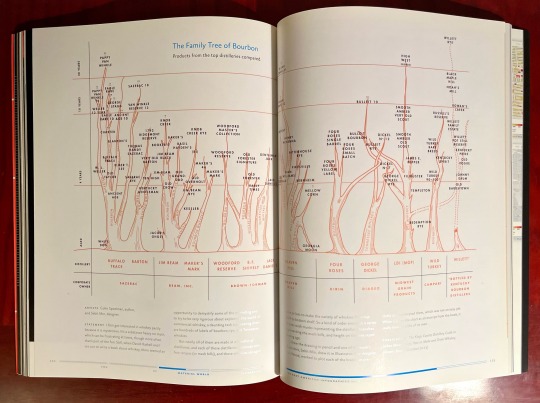
Book 485
The Best American Infographics 2014
Nate Silver / Gareth Cook
Mariner Books 2014
So, Mariner Books, who has been publishing the Best American series for more than a century, I think only published Infographics for four years, between 2013 and 2016. I get why it didn’t work and why they don’t publish it anymore. It was kind of expensive, a bit unwieldy, and probably didn’t sell all that well. That’s too bad, because it is a very interesting way to look at a year. Now, I don’t really remember what happened in 2013, but by thumbing through this book, I have a guess.
There are infographics comparing the haircuts of Peyton Manning and Tom Brady, which states have the most closeted gay people, house fire damage, hate speech on Twitter, the debt ceiling, how a new Pope is chosen, the NSA’s surveillance, unmanned space missions, bees, the fashion of Justin Bieber, tornadoes, drone attacks, and much more.
Like I said, it’s an interesting way to look at a year.
#bookshelf#library#personal collection#personal library#books#bibliophile#book lover#illustrated book#booklr#graphic design#best American infographics#2013#Nate silver#Gareth cook#mariner books
6 notes
·
View notes
Photo

(link)
9 notes
·
View notes
Text
Today's big firing was Nate Silver. This time it was ABC News' turn.
1 note
·
View note
Link
2 notes
·
View notes
Text
“Biden needs to reassure the American public that he’s capable of handling public appearances that aren’t on easy mode. Or he needs to stand down. Or he’s probably going to lose to Trump.”
— Nate Silver, the founder of FiveThirtyEight, 2/19/2024.
0 notes
Text
Racing to the bottom?
I have followed Nate Silver, an American statistician and writer who analyzes baseball, basketball, and elections. He was the founder of FiveThirtyEight (the number of electors in the United States electoral college), and held the position of editor-in-chief there, along with being a special correspondent for ABC News, until May 2023. He rose to national fame for his deadly accurate predictions…

View On WordPress
0 notes
Text
Fivethirtyeight as its stands now is trash and here’s why. (Tldr nate silver got fired and now 538 is gonna be leftist cherry picking)
0 notes
Text
Will a South African "Nate Silver" emerge after the South African elections?
Is there a South African Nate Silver? http://wp.me/pSc3Y-en
South Africa votes 2014
Tomorrow’s South African election represents 20 years of ANC rule. This election represents the first opportunity to vote for the so-called “born frees” – those born after the first democratic election in 1994 – to vote.
In 2012, Nate Silver successfully predicted the results of the US elections by consolidating and extrapolating the results of multiple polls.
Can…

View On WordPress
1 note
·
View note
Text

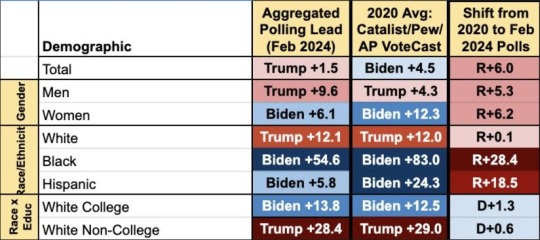

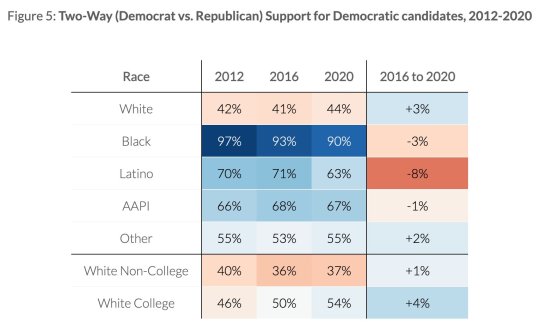


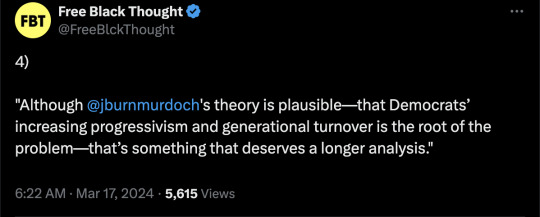

By: Nate Silver
Published: Mar 15, 2024
Earlier this week, John Burn-Murdoch of the Financial Times posted a thread that purported to show substantial losses for Democrats among non-white voters, which he termed a “racial realignment”. If you’re an election data junkie, you’ve probably seen it; it’s been viewed more than 7 million times on Twitter. Here is the graphic that kicked it off:

It’s worth reading the whole thread. There’s a lot of data, and Burn-Murdoch notes that the problems are particularly bad for Democrats among working-class voters of color, and younger ones. Many Black, Hispanic and Asian American voters have long identified as moderate or conservative rather than liberal, and Burn-Murdoch theorizes that Democrats’ tilt toward more liberal policies (though I’d prefer to call them “left” or “progressive” rather than “liberal”) is catching up with them, especially as memory of the Civil Rights Era fades.
The thread triggered its share of responses from the usual suspects, part of a recent pattern of poll denialism among Democrats that has crept its way into even the White House. And it’s true that there are some things you could critique. Burn-Murdoch is mixing and matching data from different polls, and the observation from 2024 is based solely on the recent New York Times / Siena College poll, which has a relatively small sample size; I’d rather that he’d have taken an average of different surveys.
If he’d done that, though, he’d likely have found the same thing. As you may know, I’m not much of a fan of digging into poll crosstabs. Because of the small sample sizes an
d difficulties in reaching certain underrepresented groups, you can always find something “wrong” with them and use that to dismiss polling results you don’t like. However, the Adam Carlson1 has been performing an invaluable service by aggregating the results of different polls together, which at least solves the sample size problem. And he’s finding that Joe Biden’s share of the vote has dropped dramatically among Black and Hispanic voters as compared with an average reliable estimates of the 2020 vote:

As you can see, Biden’s margin against Donald Trump has basically not moved an inch among white voters; he’s losing them by 12 percentage points, as he did in 2020. However, Biden is now only winning Hispanics by 7 percentage points — down from 24 points in 2020 — and Black voters by “only” 55 points, as compared with 83 points in 2020.
I’m not going to cover every possible difficulty when surveying non-white voters, who generally have lower response rates to polls than white voters do. I’m just saying this has been a consistent pattern; Carlson has been doing the same analysis for months now, and he’s been finding the same thing every time. So at the very least, Democrats can’t wish this problem away by complaining about small sample sizes, although that doesn’t mean they won’t try.
But polls, schmolls. Is it really plausible that there could be swings this large when it comes to actual votes?
Sure. It’s at least plausible. Let’s look at data from two places where non-white voters are plentiful. One is somewhere I’ve never been to, Starr County in South Texas, and the other is the place where I live, New York City.
Starr County is 98 percent Hispanic — the most of any county in the country outside of Puerto Rico — which makes it a uniquely valuable data point. There are no possible problems with ecological inference — misconstruing the behavior of individuals or particular subgroups from aggregate data — when basically everyone there is Hispanic. Starr County is also quite poor, in the Rio Grande Valley along the Mexican border, so it’s a particularly good place to look for patterns among working-class Hispanics. And what’s happening there ought to be frightening to Democrats. Here are the presidential election results in Starr County from 2008 through 2020:

I’ve charted these as the total number of votes rather than just the vote margin, because that’s really what tells the story. Biden received about as many votes in Starr County as Hillary Clinton did in 2016, or as Barack Obama did in 2008 or 2012. But Trump surged from receiving 2218 votes in 2016 to 8247 votes, almost four times as many, in 2020. I’ve rarely seen anything like that, especially in the contemporary American political landscape where partisan preferences tend to be relatively stable. Turnout was much higher in Starr County in 2020 — but those new voters came out overwhelmingly for Trump, contradicting the longstanding belief that Democrats benefit from higher turnout among minority groups. The shift of the Hispanic vote in South Texas has undermined Democrats’ dreams of turning Texas blue, or at least purple, offsetting gains that Democrats have made in the Houston, Dallas and Austin metro areas.
It’s not just a Trump thing, either. In 2022, Henry Cuellar, the Democratic congressman in Texas’s 28th congressional district which represents Starr County and others along the Mexican border, won by 13 points. That’s not bad, I guess. But Cueller had won the race by 19 points in 2020, and by 69 points in 2018 against a Libertarian candidate as Republicans hadn’t even bothered to contest the race. He won by 35 points in 2016, when Republicans did have a nominee.
Another place to find heavy concentrations of non-white voters is New York City. And here are the results there in presidential and gubernatorial elections since 2012 in the five boroughs as well as the three innermost suburban counties, Westchester County north of New York City on the mainland, and Nassau and Suffolk counties on Long Island:
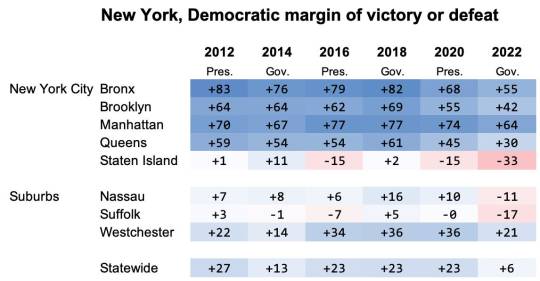
The story here is somewhat more nuanced: Andrew Cuomo, the Democrats’ gubernatorial nominee in 2014 and 2018, was relatively popular in Long Island and in Staten Island, whereas the Republican gubernatorial nominee in 2022, Lee Zeldin, represented Eastern Long Island (mostly Suffolk County) in Congress.
But still, these trends are ominous for Democrats. In the Bronx, where less than 10 percent of the population is non-Hispanic white, Democrats went from winning the presidential race by 83 points in 2012 to winning the gubernatorial race by only 55 points in 2022, a 28-point swing. And there was a 29-point swing against Democrats in Queens — which is just 26 percent non-Hispanic white — between 2012 and 2022. Democrats’ results have been steadier in wealthier (although still relatively diverse) Manhattan, conversely, and in well-to-do Westchester County.
Nationwide trends aren’t this dramatic, although you see some of the same pattern. Modeling from Catalist, a Democratic firm, found that Democrats went from getting 97 percent of the two-party Black vote (that is, the vote excluding third parties) in 2012 to 90 percent in 2020. And they dropped from 70 percent of the Hispanic vote to 63 percent over the same period:

Democrats’ share of the Asian American vote had been steadier by comparison — but then it fell substantially in the 2022 midterms as compared with 2020, according to a Catalist analysis:
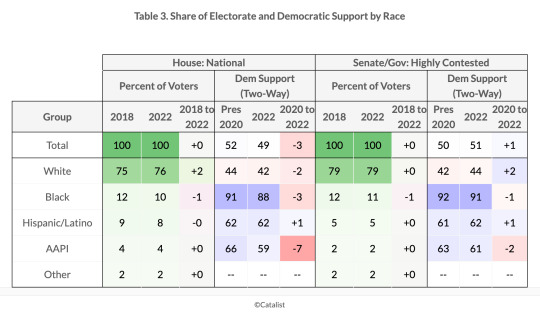
It’s worth pointing out that Black voters overall are still heavily Democratic. But going from 97 percent of the vote to 90 percent — not to mention 80 percent as more recent polls have found — is an enormous problem for the party. Democrats have become increasingly dependent on the votes of college graduates, but college grads are the minority — about 40 percent of people aged 25 and older have a bachelor’s degree or higher, and the share is no longer really increasing as the number of Americans attending college is leveling off, particularly among men. Without winning huge majorities of Black voters, and solid majorities of Hispanics and Asian Americans, Democrats’ electoral math doesn’t add up to a majority.
Let’s keep it to that, for now. Although Burn-Murdoch’s theory is plausible — that Democrats’ increasing progressivism and generational turnover is the root of the problem — that’s something that deserves a longer analysis. What he’s seeing in the data shouldn’t be dismissed as some kind of outlier, however. It’s been replicated in poll after poll, and it has become increasingly apparent in election results, too.
#Free Black Thought#Nate Silver#US politics#Democratic Party#Republican party#US elections#religion is a mental illness
1 note
·
View note
Text


1 note
·
View note
Text
"Whereas Silver, I would think, for all of his openness and naivety... is hesitant to make new friends, because he's used to seeing them die. You don't want to make connections after a point, but he is also, y'know, clearly desperate to make connections, because he's a people person. He likes other people, he wants to be around other people, he wants to protect people." -- Ian Flynn, on Silver the hedgehog


(NOTE: this quote is from an upcoming Espilver BumbleKast Mini sponsored by @transmanshadow!)
#rabbit.txt#silver the hedgehog#sonic the hedgehog#idw sonic#idw silver#NATE SENT ME THE LINK TO THE MP3 FOR THE ESPILVER MINI AND I AM NOT EVEN ONE QUESTION IN AND IM A WRECK#SILVER HAS SEEN SUCH HORRIBLE THINGS! HES SEEN PEOPLE HE LOVES DIE!!! ITS HAPPENED SO OFTEN THAT HES USED TO IT! HE EVEN EXPECTS IT!!!#FUCKING DEVASTATING THANK YOU MR FLYNN#btw hearing this quote totally solidified my desire to at some point be on the show as a guest episode.#talking about Silver... for a whole hour... with one of the professional hedgehog understanders themselves!
532 notes
·
View notes
Photo

(link)
0 notes
